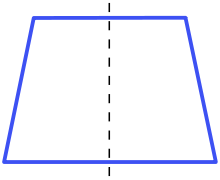isosceles
English
[edit]

Etymology
[edit]Borrowed from Latin īsoscelēs, from Ancient Greek ἰσοσκελής (isoskelḗs, “equal-legged”), from ἴσος (ísos, “equal”) + σκέλος (skélos, “leg”) + -ής (-ḗs, adjective suffix).
Pronunciation
[edit]- IPA(key): /aɪˈsɒsəliːz/
Audio (Southern England): (file)
Adjective
[edit]isosceles (not comparable)
- (geometry) Having (at least) two sides of equal length, used especially of a triangle or trapezoid.
- 1693, Abel Swall, transl., The New Method of Fortification, as Practised by Monsieur de Vavban, Engineer General of France, 2nd edition, "A New Treatise of Fortification", page 96:
- Upon each exterior side draw an Isosceles Triangle of 480 Fathoms.
- 1914, Henry Parker Manning, Geometry of Four Dimensions, page 204:
- A right double pyramid is isosceles when the extremities of the vertex-edge are at the same distance from the plane of the base.
- 1945, Harold E. Wolfe, Introduction to Non-Euclidean Geometry, page 31:
- To prepare for the application of his method, Saccheri made use of a figure with which we are already acquainted. This is the isosceles quadrilateral with the two base angles right angles.
- 1965 April 8, Newton B. Dismukes, “Multihull vessels (Patent US3316873A)”, in Google Patents[1]:
- The polygon advantageously is an isosceles trapezoid or rectangle with the pivotal connections between the deck or superstructure and four hulls respectively at its corners.
- 2019 January 23, Altered Book Lover, “Funky Flowers”, in Blogspot[2]:
- The flowers were stuck inside a flower pot that was shaped like an isosceles polygon with a rectangular "edge."
Usage notes
[edit]- A trapezoid with two equal sides and two unequal sides is normally described as unequilateral, even though it can be regarded as a special case of isosceles trapezoid.
- A triangle with three equal sides is normally described as equilateral, even though it can be regarded as a special case of isosceles triangle.
Derived terms
[edit]Translations
[edit]
|
Further reading
[edit] Isosceles trapezoid on Wikipedia.Wikipedia
Isosceles trapezoid on Wikipedia.Wikipedia  Isosceles triangle on Wikipedia.Wikipedia
Isosceles triangle on Wikipedia.Wikipedia  Isosceles (disambiguation) on Wikipedia.Wikipedia
Isosceles (disambiguation) on Wikipedia.Wikipedia
Anagrams
[edit]Latin
[edit]Etymology
[edit]Borrowed from Ancient Greek ἰσοσκελής (isoskelḗs), from ἴσος (ísos, “equal”) + σκέλος (skélos, “leg”) + -ής (-ḗs, adjective suffix).
Pronunciation
[edit]- (īsoscelēs): (Classical Latin) IPA(key): /iːˈsos.ke.leːs/, [iːˈs̠ɔs̠kɛɫ̪eːs̠]
- (modern Italianate Ecclesiastical) IPA(key): /iˈsoʃ.ʃe.les/, [iˈs̬ɔʃːeles]
- (īsosceles): (Classical Latin) IPA(key): /iːˈsos.ke.les/, [iːˈs̠ɔs̠kɛɫ̪ɛs̠]
- (modern Italianate Ecclesiastical) IPA(key): /iˈsoʃ.ʃe.les/, [iˈs̬ɔʃːeles]
Adjective
[edit]īsoscelēs (genitive īsoscelis); third-declension one-termination adjective
Declension
[edit]Third-declension one-termination adjective (Greek-type).
| singular | plural | ||||
|---|---|---|---|---|---|
| masc./fem. | neuter | masc./fem. | neuter | ||
| nominative | īsoscelēs | īsosceles1 īsoscelēs |
īsoscelēs | īsoscela īsoscelia2 | |
| genitive | īsoscelis | īsoscelum īsoscelium2 | |||
| dative | īsoscelī | īsoscelibus | |||
| accusative | īsoscelem | īsosceles1 īsoscelēs |
īsoscelēs | īsoscela īsoscelia2 | |
| ablative | īsoscele īsoscelī2 |
īsoscelibus | |||
| vocative | īsosceles1 īsoscelēs |
īsoscelēs | īsoscela īsoscelia2 | ||
1It is unknown if Classical Latin preserved (or would have preserved) the shortness of the original Greek short ending.
2It is unknown whether adjectives of this type would use i-stem or consonant-stem endings in Classical Latin: the relevant forms are not attested. Depending on the word, either ending or both may be attested in New Latin.
Notes:
- The Greek masculine and feminine nominative singular is ἰσοσκελής (isoskelḗs), while the masculine and feminine vocative singular and the neuter nominative, accusative and vocative singular are ἰσοσκελές (isoskelés). Maybe Latin preserved the short length of the epsilon (ε), or maybe it did not so that the declension became similar to Latin third declension adjectives of one ending (like felix).
- This word is often used together with triangulum n and rarer with triangulus m.
References
[edit]- “īsoscĕles”, in Charlton T. Lewis and Charles Short (1879) A Latin Dictionary, Oxford: Clarendon Press
- īsoscĕlēs in Gaffiot, Félix (1934) Dictionnaire illustré latin-français, Hachette, page 860/3.
- English terms borrowed from Latin
- English terms derived from Latin
- English terms derived from Ancient Greek
- English 4-syllable words
- English terms with IPA pronunciation
- English terms with audio pronunciation
- English lemmas
- English adjectives
- English uncomparable adjectives
- en:Geometry
- English terms with quotations
- Latin terms borrowed from Ancient Greek
- Latin terms derived from Ancient Greek
- Latin 4-syllable words
- Latin terms with IPA pronunciation
- Latin lemmas
- Latin adjectives
- Latin third declension adjectives
- Latin third declension adjectives of one termination
- la:Geometry
- Latin terms prefixed with iso-
